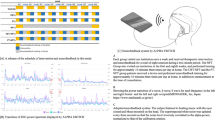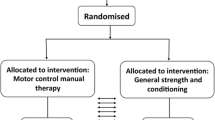Abstract
Eighteen patients with chronic low back pain(lbp) of muscle tension origin were given an EMG biofeedback training. Compared to seven controls they showed a significant decrease during training in muscle tension and subsequently in pain. However, at follow-up EMG levels dropped to the initial(high) level. Pain scores of patients with high pain decrements during training showed further improvement during follow-up, which was not the case with patients showing less substantial improvement. The importance of cognitions was discussed.
Similar content being viewed by others
References
Birbaumer, N. Biofeedback training: A critical review of its clinical applications and some future directions.European Journal of Behavioural Analysis and Modification 1976/1977,4 235–251.
Brown, B. B.Stress and the art of biofeedback. New York: Harper & Row, 1977.
Budzynski, T. H. Biofeedback procedures in the clinic.Seminars in Psychiatry 1973,5(4), 537–547.
Budzynski, T. H., Stoyva, J. M., & Adler, C. S. Feedback-induced muscle relaxation: Application to tension headache.Journal of Behavior Therapy and Experimental Psychiatry 1970,1 205–211.
Budzynski, T. H., Stoyva, J. M., Adler, C. S., & Mullaney, D. J. EMG biofeedback and tension headache: A controlled outcome study.Psychosomatic Medicine 1973,35 484–496.
Cox, D. J., Freundlich, A., & Meyer, R. G. Differential effectiveness of electromyograph feedback, verbal relaxation instructions, and medication placebo with tension headaches.Journal of Consulting and Clinical Psychology 1975,43(6), 892–898.
Davison, G. C., & Valins, S. Maintenance of self-attributed and drug-attributed behavior change.Journal of Personality and Social Psychology 1969,11(1), 25–33.
Dorpat, Th. L., & Holmes, Th. H. Backache of muscle tension origin. In W. S. Kroger (Ed.),Psychosomatic obstetrics, gynecology and endocrinology. Springfield Illinois: Charles C Thomas, 1962. Pp. 425–436.
Epstein, L. H., & Abel, G. G. An analysis of biofeedback training effects for tension headache patients.Behavior Therapy 1977,8 37–47.
Epstein, L. H., & Blanchard, E. B. Biofeedback, self-control, and self-management.Biofeedback and Self-Regulation 1977,2(2), 201–211.
Fordyce, W. E.Behavioral methods for chronic pain and illness. Saint Louis: C. V. Mosby, 1976.
Grabel, J. A. Electromyographic study of low back muscle tension in subjects with and without chronic low back pain.Dissertation Abstracts International 1973,34(6-B), 2929–2930.
Grzesiak, R. C. Relaxation techniques in treatment of chronic pain.Archives of Physical and Medical Rehabilitation 1977,58 270–272.
Hefferline, R. F. The role of proprioception in the control of behavior.Transactions of the New York Academy of Sciences 1958,20 739–764. Cited by B. B. Brown,Stress and the art of biofeedback. New York: Harper & Row, 1977. P. 41.
Holmes, Th. H., & Wolff, H. G. Life situations, emotions, and backache.Association for Research in Nervous and Mental Disease. Proceedings 1950,29 750–772.
Kondo, C. Y., Canter, A., & Bean, J. A. Intersession interval and reductions in frontalis EMG during biofeedback training.Psychophysiology 1977,14(1), 15–17.
Meichenbaum, D. Cognitive factors in biofeedback therapy.Biofeedback and Self-Regulation 1976,1(2), 201–217.
Philips, C. The modification of tension headache pain using EMG biofeedback.Behaviour Research and Therapy 1977,15 119–129.
Reeves, J. L. EMG-biofeedback reduction of tension headache: A cognitive skills-training approach.Biofeedback and Self-Regulation 1976,1(2), 217–225.
Staudemayer, H., & Kinsman, R. A. Awareness during electromyographic biofeedback: Of signal or process?Biofeedback and Self-Regulation 1976,1(2), 191–199.
Sternbach, R. A., Wolf, S. R., Murphy, R. W., & Akeson, W. H. Traits of pain patients: The low-back ‘loser’.Psychosomatics 1973,14 226–229.
Stoyva, J. M., & Budzynski, T. H. Cultivated low arousal—an antistress response? InBiofeedback and self-control 1974. Chicago: Aldine, 1974. Pp. 265–290.
Vazuka, F. A. Etiology and mechanisms in development of the low back syndrome. In J. H. Nodine & J. H. Moyer (Eds.),Psychosomatic medicine. Philadelphia: Lee and Febiger, 1962. P. 157–163.
Author information
Authors and Affiliations
Additional information
We wish to express our thanks to Marijke Höweler-van Dalen for supervising this investigation, to Arnold Goedhart for statistical advice, to Dr. Orlebeke for his critical remarks, and to Dr. Penders for referring the patients in Amsterdam. We are particularly indebted to the general practitioners Paul Kreutzer and Jan Huls for referring the Andijk patients. Without their support this investigation would not have been possible.
Rights and permissions
About this article
Cite this article
Nouwen, A., Solinger, J.W. The effectiveness of EMG biofeedback training in low back pain. Biofeedback and Self-Regulation 4, 103–111 (1979). https://doi.org/10.1007/BF01007105
Received:
Issue Date:
DOI: https://doi.org/10.1007/BF01007105




